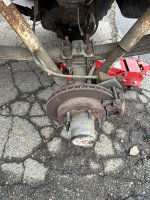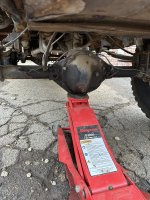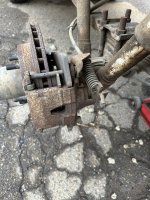Yes, they are. A good application to ask for at the parts store (or to order online) is 79-85 Cadillac Eldorado. These calipers are now reproduced as well and sold by a wide variety of vendors.
Todd Z.
So a little tweak right back at you... Here's some useful jargon that might help in the spare parts look-up.
There are two different sized Cadillac calipers. There is the Seville caliper, which is the small GM caliper, and there is the El Dorado caliper, which is the large GM caliper. The Seville Caliper came out in 1977 and is the one that everyone pretty much adapted right away. It has a 2.5 inch piston, and it's looking for about a 15/16 thick rotor. In 79, the Seville got an oddball caliper with metric fittings, and a 2-1/8 inch bore. Then from 80-85, the Seville got the same GM metric small caliper with the 2 inch bore. The bolt spacing on this caliper is about 5 inches.
The El Dorado got rear discs in 1976, and those ran from 76-78...but they are the large format GM caliper with a 2.5 inch bore, and SAE fittings. It is looking for a 1.205 inch thick rotor. This is the ubiquitous GM caliper that you will see on most 1-ton rear axle disc conversion. The bolt spacing on the caliper is about 7 inches. In 1979, the El Dorado got the small format caliper. In the jargon of the day, the El Dorado got the Seville caliper.
In the JEEP world, anytime someone says "El Dorado" disc brakes, it is GENERALLY accepted that they mean large format, thick rotor, 76-78 GM Big caliper.
Anytime someone says "Seville" caliper, it means small format, thin rotor, 80-85 GM metric small caliper. Anytime someone puts a big piston 77-78 Seville caliper on a rear end...someone usually asks: "why did you do that?"
As mentioned above, the Seville caliper fits the rotor thickness of about 15/16 inch, and the Jeep CJ5 caliper happens to have a 7/8 thick rotor. So Viola! Those go together.
So when people say Cadillac caliper, it was always referenced in Context. Jeep rear disc guys meant early Seville calipers. GM 14 bolt guys meant El Dorado calipers. This was back in 1979...so nobody had the foresight to think that Cadillac would someday use the tiny Seville Calipers on an El Dorado! So if you keep the 1980's point of reference...It was all very simple. Generally, the name goes to the first application or deployment. The 79 El Dorado is the oddball that breaks the naming convention. Please remember that we are in junkyard shopping context now. You cannot see the caliper piston bore when the caliper is mounted on a wrecked axle in the mud. And you only get a few seconds to look at it as the yard-monkey walks you around. So you see something strange, and you peek underneath, and you notice a rear disc axle. The conversation usually goes like: "When did they start putting Cadillac calipers on the Camaro?"
1. El Dorado Caliper - (76-78 El Dorado) Large format, SAE fitting, 2.5 inch bore, 1-1/8 rotor thickness.
2. Seville Caliper. - (77-78 Seville) Small format SAE fitting, 2.5 bore, 15/16 rotor thickness.
3. Camaro Caliper - (78-81 Camaro + 79 Seville) Small format, metric fitting, 2.5 bore, 15/16 rotor thickness.
4. Late Seville Caliper - (80-85 Seville + 79-85 El Dorado) Small format, metric fitting, 2-1/8 bore, 15/16 rotor thickness.
That ought to confuse pretty much everybody, but it makes perfect sense to me. The Late Seville caliper is often mis-named the Metric Caliper, or the late El Dorado caliper. It is also often just named "Seville Caliper" for short. This is because the 77-78 Seville Caliper was very rare, and in short supply in 1980. The parking brake was problematic, and they didn't last long in a wrecking yard. So you couldn't find them, you couldn't see them, and from 10 feet away, they were exactly the same.
Now when someone says "Cadillac caliper," I just smile and nod. And ask for pictures.













